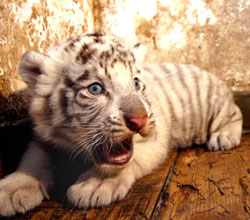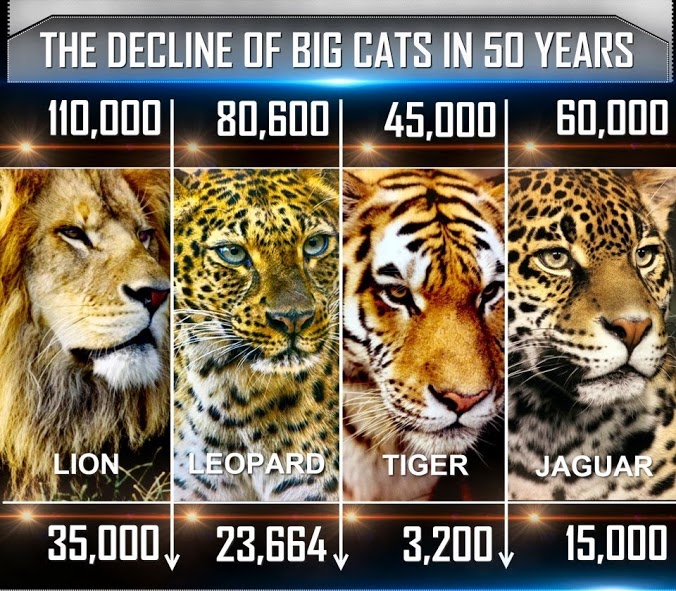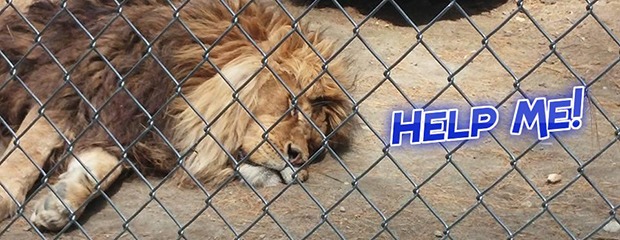Pet a Tiger Cub?
Wondering if it is ever OK to pet a lion cub or a tiger cub? Get the most updated info on cub handling here. https://bigcatrescue.org/
Want to end the abuse of cubs? Text CATS to 52886 Data and Messaging rates may apply.
Below are older efforts to save cubs, but for the most recent, go to the link above.

The World Wildlife Fund just launched a campaign to restrict and regulate the trade in tigers called “Tigers Among U.S.” It updates the information gathered for their “Paper Tigers” report from 2008 with data collected by Big Cat Rescue and other International Tiger Coalition partners. It is clear that the virtually unregulated trade in captive bred tigers in the U.S. provides a legal cover for illegal activities that are causing the wild tiger to disappear at a rate of one tiger per day, with less than 3,200 tigers left in the wild as of 2015.
The reason tigers are so openly bred and traded in the U.S. is because according to an online poll that asks, “Did you know that having your picture made with a cub will result in that cat living a miserable life in a tiny cage, or that he may end up being killed for his bones, skin and meat?” 54% of the respondents said they were unaware of the abuse that such an activity inflicts. Back in the 1980’s the US Fish & Wildlife Service experienced so many applications for permits to breed tigers for circus acts, roadside zoos and sales that they did not have the manpower nor funding to process all of the permits. In what turns out to be the worst decision ever made for tigers, they decided to create a loophole called “generic tigers” so that they would not have to deal with the paperwork and deemed that any tiger that was not purebred, and thus of no value to real conservation, could be bred without a permit.
The charlatans who were already breeding tigers in captivity now had virtually no oversight on their activities and could purposely inbreed tigers in order to fill the public’s demand to see white tigers. The public’s demand for seeing white tigers and ligers is waning because of Big Cat Rescue’s decade long educational outreach via the Internet about the truth about white tigers. In light of the information being made easily available on Big Cat Rescue’s website, even the American Zoological Association had to crack down publicly on their member zoos that were inbreeding and cross breeding. Now the only places that still breed white tigers are the worst of the worst.
Nowadays the main cause of tigers being bred, used and discarded is because of the public’s demand to touch the wild. The same breeders, dealers and exploiters of tigers are churning out tiger cubs by the hundreds each year, under the guise of conservation, because it is easy to deceive the public into doing something they really want to be able to do with a clear conscience.
The way Big Cat Rescue combats this abhorrent practice is a multi-pronged approach. They only allow visitors to the world’s most influential accredited sanctuary that is devoted entirely to cats on guided tours. During the tour the guide educates the guests about how the animals ended up needing rescue and what they can do to end the cause at its root. This method can only reach a small number of people each year though, and the problem in global.
The website gets nearly 3 million visitors per year and is another educational tool that provides the information about what it really means to pet a tiger cub and gives the viewer easy ways to become part of the solution in saving tigers, rather than leading to their demise. The Internet has become the best way to reach the most people with information about why it is wrong to pay to pose with a tiger or pay to see a tiger cub, or pay to swim with a tiger cub or pay to play with baby big cats.

This is how it is done.
Google alerts are a great way to find out what people are talking about right now and join the conversation. Search.Twitter.com is another and there are unlimited ways now to have the information about tiger displays, circus acts and magic acts that exploit tigers, lions and other big cats sent right to your desk. As those alerts from google come in, Big Cat AdvoCats all around the world leap into action.
When some traveling act that uses lions, tigers or other exotic cats posts on a community calendar that they are bringing the big cats to fairs, flea markets, malls, parking lots, festivals and other off site venues that information is acted upon right away. The same goes for any misguided press they receive from reporters who are part of that 54% of people who are ignorant to the abuse, although they could easily change that by just googling the name of the exhibitor, in most cases. Unfortunately, exhibitors change their names frequently to avoid detection.
Big Cat AdvoCats will then call the owner of the venue or the manager of the event and explain to them why bringing a big cat exhibit to their place shows they do not understand about the abuse behind the scenes and why it will offend their patrons who do know better. Almost half of the public does know that big cats belong in the wild and that big cats do not belong in cages, traveling wagons, or other cramped quarters where they are deprived of everything that makes them such magnificent animals who inspire awe and respect. In many cases, once the owner of the venue knows the facts behind the hype the abusers have given them, in order to gain access to their crowds, the owner will cancel the act immediately.
In some cases though, the owner or manager either doesn’t care or doesn’t want to believe that there isn’t some redeeming factor to having big cats at their event. They are either embarrassed to have advertised something they won’t provide, or they don’t believe the public will know why it is such a bad idea to bring big cats out in public. When that is the case, Big Cat Rescuers will reach out to other volunteers and ask them to call, mail or email the venue owner to show them that it isn’t a matter of a personal feud between a real sanctuary and a pseudo sanctuary, but rather is about animal abuse and how allowing these abusers to set up camp in their midst associates all of the evil they are doing to animals with the venue owner.
Sometimes, a few dozen such contacts are still brushed aside, or the venue owner will refuse to speak with Big Cat Rescuers about the situation at all. When that is the case, Big Cat Rescue relies on their huge database of people who care about animals and the online advocacy product CatLaws.com hosted by Salsa which now can be accessed directly from Facebook. The people who have refused to listen or believe the initial callers will be targeted by the alert in such a way that anyone who discovers their affiliation with a person who uses cubs for petting and photo ops will be emailed, phoned or will get written letters by thousands of people who are in that 46% who do know better.
As Facebook and other online social networks increase in popularity it provides yet another way that the educated individuals can reach out to inform those who are still in the dark about big cat abuse. In a recent situation a bar owner had promoted on Facebook that he was having a live, baby tiger cub to be brought to the bar. Within hours he was contacted by Big Cat Rescuers, but did not return calls and emails. The next day his Facebook page was filling up by the minute with thousands of people who were asking him to cancel the display. “My email inbox kept crashing due to the volume of email. I got 55 calls this morning and when some of them even turned out to be my own longtime customers, who said they would be offended by such an act, I decided to cancel the tiger cub.” said the manager.
When a backyard zoo that offers opportunities to pet baby cougars, baby white tigers and swim with tiger cubs recently decided that Facebook wasn’t getting them enough paying customers, they went to PetSmart to drum up some business. They had been run out of a mall just months before for bringing a tiger on a leash that was too big and dangerous, so they acquired four more cubs who were just weeks old to exploit. They managed to kill one within weeks as young cubs were never meant to be ripped from their mothers, bottle raised and handled for hours on end.
When Big Cat Rescuers and their supporters complained to PetSmart, this forward thinking company took immediate action. According to corporate spokesperson Margie Wojciechowski at the Phoenix, AZ headquarters, she confirmed she had just come from a meeting and the company has “reinforced with our managers that no exotic pets are allowed on store premises. There will be no live display of exotic animals for events.”
There has been a tremendous shift taking place now that the world is becoming more interconnected and news is being reported in real time. As more people learn about the abuses behind breeding lions and tigers for lives of deprivation and confinement they will not pay to see cubs who have been bred into this morally corrupt industry. For those who want to have their cake, and eat it too, there is no such recipe for captive tigers. No legitimate facility, be it zoo or sanctuary or rehab center, allows public contact because it never turns out well for the animal and often leads to injury of the public. There are no legitimate breeding facilities for lions, tigers or other big exotic cats for conservation nor return to the wild, despite a lot of money making enterprises who use those phrases to fool the public.
If you love tigers and other wildcats there are lots of things you can do to protect them in the wild because now you are part of that 54% who know that big cats don’t belong in cages.
See the video only here:
Three Things to Know About Petting a Cub
There are a some lion and tiger cub exploiters still making the rounds at fairs, flea markets, parking lots and malls who are charging the public $10 – $25 to pet a baby lion cub or to play with a baby tiger cub.
USDA regulations should over ride state regulations on this matter, but in Florida the FL Wildlife Commission has set its own standard that may differ a bit, but not much from USDA’s ruling.
Here is what the law says about that:
Cubs should not be handled by the public before the age of 8 weeks because they are not old enough to have had their first kitten vaccination. Cubs need to be vaccinated at 8, 10 & 12 weeks of age to build up an immune response, so it is really irresponsible to allow contact before 12 weeks. USDA cites the prohibition on contact with cubs under the age of 8 weeks in their Big Cat Q & A download.
USDA defines a juvenile big cat as being any cub over the age of 12 weeks and does not suggest public contact with cubs over the age of 12 weeks. Despite the fact that touching cubs between the age of 8 weeks and 12 weeks is potentially deadly to the cub, USDA does currently (2015) allow public contact with cubs over 8 weeks and under 12 weeks of age.
In USDA vs Palazzo the courts ruled, “…it is now manifestly clear that USDA has changed its position, finding there to be “an inherent danger present for both the viewing public and the exhibited animals(s) where there is any chance that the public could come into direct contact with juvenile or adult big cats”…and finding that…”For regulatory purposes, APHIS generally considers big cats to become juveniles when they reach 12 weeks of age. 11 CX 20 goes on to explain that “According to Dr. Gibbens’ testimony, the policy precluding direct public contact with juvenile tigers was in effect in 2004 & was placed on the USDA’s website in 2005.
https://www.911animalabuse.com/images/USDAViolations/2010GreatCatAdventures3YrSuspension.pdf
Florida law only allows contact up to 25 lbs for exotic cats. This works out to roughly the same 12 week limit that USDA has imposed, but Florida law does not protect cubs under that weight limit, despite age.
(a) Public contact and exhibition.
1. General: All Class I, II or III wildlife that will be used for contact with the public shall have been evaluated by the exhibitor to insure compatibility with the uses intended. All wildlife shall be exhibited in a manner that prevents injuries to the public and the wildlife. The exhibitor shall take reasonable sanitary precautions to minimize the possibility of disease or parasite transmission which could adversely affect the health or welfare of citizens or wildlife. When any conditions exists that results in a threat to human safety, or the welfare of the wildlife, the animal(s) shall, at the direction of a Commission officer, be immediately removed from public contact for an interval necessary to correct the unsafe or deficient condition.
2. Class I wildlife shall only be permitted to come into physical contact with the public in accordance with the following:
a. Full contact: For the purpose of this section, full contact is defined as situations in which an exhibitor or employee handler maintains proximate control and supervision, while temporarily
surrendering physical possession or custody of the animal to another.
Full contact with Class I wildlife is authorized only as follows:
I. Class I cats (Felidae only) that weigh not more than twenty-five (25) pounds;
https://www.flrules.org/gateway/readFile.asp?sid=0&tid=7515480&type=1&File=68A-6.0023.doc
Further the US Fish & Wildlife Service defines a sanctuary as a facility that does not allow contact between the animals and the public.
Accredited wildlife sanctuary means a facility that cares for live specimens of one or more of the prohibited wildlife species and:
(1) Is approved by the United States Internal Revenue Service as a corporation that is exempt from taxation under § 501(a) of the Internal Revenue Code of 1986, which is described in §§ 501(c)(3) and 170(b)(1)(A)(vi) of that code;
(2) Does not commercially trade in prohibited wildlife species, including offspring, parts, and products;
(3) Does not propagate any of the prohibited wildlife species; and
(4) Does not allow any direct contact between the public and the prohibited wildlife species.
More about Petting Tiger Cubs






Wade until you learn how to spell you shouldn't write on here…lol
Kim Wilmot Golden do you mean wait?